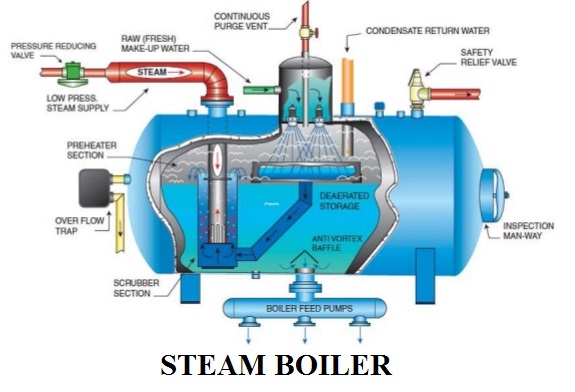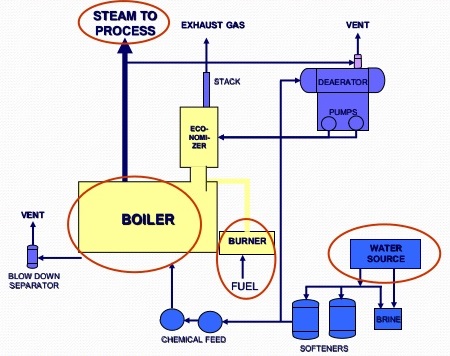Below is a typical steam boiler diagram for dummy’s to understand with name of each component or boiler part. First of all you should understand that there are many types and nomenclature of boilers. For example steam boiler, combi boiler, vaillant boiler, hot water boiler, gas boiler, electric boiler, weil mclain boiler, condensing boiler, oil boiler, burnham boilers, central boiler, lochinvar boiler, water tube boiler, system boiler, central heating boilers, buderus boiler, bosch boilers, biasi boiler, ferroli boiler, peerless boilers, wood boiler, hartford steam boiler, utica boilers, crown boiler and many other industrial boilers.
The main classification of boilers is in two categories i.e. water tube boilers and fire tube boilers. Fire tube boilers are useful for small demands of steam and water tube boilers are useful for industrial level usage.
To cut short the main purpose of boiler is to boil a liquid mostly the water in order to generate the steam for serving the purpose of heating a building or running an equipment through pressurized steam or pressurized water.
To make the concept more clear steam produced in a boiler may be useful for:
- Producing mechanical work by expanding it in steam engine or steam turbine and thermal power plants.
- Heating the residential and industrial buildings.
- Performing certain processes in the sugar mills, chemical and textile industries.
Steam Boiler Diagram

The diagram above is showing the boiler parts which are mandatory for the design and operation of steam boiler. Hence each boiler part plays important role and everyone interested to know more about boilers can learn from this page in the last section.
Lets first see some basic information about boilers. Boiler is a device used to generate steam at a desired pressure and temperature by transferring heat energy produced by burning fuel to water to change it to steam. Normally boiler is a combination of apparatus used for producing, furnishing or recovering heat together with the apparatus for transferring the heat so made available to the fluid being heated and vaporized.
The fluid is contained in the boiler drum called shell and the thermal energy released during combustion of fuel is transferred to water and this converts water into steam at the desired temperature and pressure.
Mandatory Boiler Mountings
- Pressure gauge
- Fusible plug
- Steam stop valve

- Feed check valve
- Blow off cock
- Man and mud(sight)holes: Used to allow men to enter inside the boiler for inspection and repair.
- Two safety valves: The commonly used safety valves are: Dead weight safety valve, Lever safety valve, spring loaded safety valve and High steam and low water safety valve.
- Two water level Indicators
Boiler Accessories
- Economizer
- Air Preheater
- Superheater
- Feed Pump
- Steam Separator
- Steam Trap
Advantages of economizer
- The temperature range between various parts of the boiler is reduced which results in reduction of stresses due to unequal expansion.
- If the boiler is fed with cold water it may result in chilling the boiler metal. Hot fed water checks it.
- Evaporation capacity of the boiler is increased.
- Overall efficiency of the plant is increased.
Major Components of Boilers
- Boiler Shell: The outer cylindrical portion of a pressure vessel. BURNER – A device for the introduction of fuel and air into a furnace at the desired velocities. The burner is the principal device for the firing of oil and/or gas.
- Mud Ring or Mud Drum: A typically cylindrical shaped space at the bottom of the water space. Sediment, mud, and other impurities gather there.
- Furnace: An enclosed space provided for the combustion of fuel.
- Safety Valve: A spring loaded valve that automatically opens when pressure attains the valve setting. Used to prevent excessive pressure from building up in a boiler.
- Steam Separator: A device for removing the entrained water from steam.
- Strainer: A device, such as a filter, to retain solid particles allowing a liquid to pass.
- Sight Glass: A glass tube used on steam boilers to give a visible indication of the boiler’s water level.
- Drain: A valve connection at the lowest point for the removal of all water from the boiler.
- Feed Pump: A pump that supplies water to a boiler.
- Ash Pit: The ash pit is the space where ashes accumulate under the fire. The ashes fall through the fire grate into a (often) removable box.
- Grate: Grate is a series of bars or narrow plates in the bottom of the fire box. The ashes fall through the grate into the ash pit.
- Pressure Gauge: Indicates the pressure of the steam in the boiler.
- Fusible Plug: Operates as a safety valve when dangerous temperatures, rather than dangerous pressures, are reached in a closed vessel.
- Feed Check Valve: The high pressure feed water is supplied to the boiler through this valve. This valve opens towards the boiler only and feeds the water to the boiler.
- Steam Stop Valve: It regulates the flow of steam supply outside.
Discover more from Electrical Engineering 123
Subscribe to get the latest posts sent to your email.


Nice